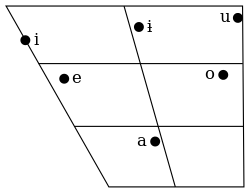Sumi language
Sema, also Sumi, is a Sino-Tibetan language spoken in Nagaland, India. It is spoken by the Sumi Naga people.[3][4]
| Sema | |
|---|---|
| Sümi (Naga) | |
| Pronunciation | [sɨ˧ mi˩] |
| Native to | India |
| Region | Nagaland |
| Ethnicity | Sumi Naga |
Native speakers | 350,000 (2011 census)[1] |
| Language codes | |
| ISO 639-3 | nsm |
| Glottolog | sumi1235[2] |
Geographical distribution
Sumi is spoken in central and southern Nagaland, in Zunheboto district, Dimapur district, Kohima district, Mokokchung district, and Tuensang district, as well as in 7 villages of Tinsukia district, Assam (Ethnologue).
Dialects
Ethnologue lists the following dialects of Sema.
- Dayang (Western Sumi)
- Lazami
- Jimomi
- Zumomi
Phonology
The transcriptions in this section use the International Phonetic Alphabet.
Vowels

The vowels of Sema are as follows:[5][6]
| Front | Central | Back | |
|---|---|---|---|
| Close | i | ɨ | u |
| Mid | e | o | |
| Open | a |
Notes:
- /i/ has been variously described as:
- /ɨ/ has been variously described as:
- In word-medial position, /ɨ/ can be realized as mid central unrounded [ə].[5][9]
- /u/ is close back rounded [u].[7][9]
- The mid vowels /e, o/ can be realized as either close-mid [e, o] or open-mid [ɛ, ɔ].[5][8]
- Teo (2012) describes the close-mid allophone of /o/ as slightly advanced [o̟].[7]
- /a/ has been variously described as:
- After uvular stops, /a/ can be realized as open back unrounded [ɑ].[9]
Consonants
The consonants of Sema are as follows[6][10] (allophones that are represented in the orthographic system are given in parentheses):
| Bilabial | Labiodental | Alveolar | Postalveolar | Palatal | Velar | Uvular | Glottal | |||
|---|---|---|---|---|---|---|---|---|---|---|
| Nasal | plain | m | n | ŋ | ||||||
| aspirated | mʱ | nʱ | ||||||||
| Plosive | voiceless | p | t | k | q | |||||
| aspirated | pʰ | tʰ | kʰ | qʰ | ||||||
| voiced | b | d | ɡ | |||||||
| Affricate | voiceless | (ts) | (tʃ) | |||||||
| aspirated | (tsʰ) | tʃʰ | ||||||||
| Fricative | voiceless | f | (s) | ʃ | x | h | ||||
| voiced | v | (z) | ʒ | ɣ | ||||||
| Approximant | central | plain | (w) | ɹ | j | |||||
| lateral | l | |||||||||
| aspirated | lʱ | |||||||||
gollark: ++remind 7mo procedural lyric generation
gollark: Perhaps.
gollark: Truly, all is b(ee).
gollark: or both.
gollark: Or my code is just bad.
References
- "Statement 1: Abstract of speakers' strength of languages and mother tongues - 2011". www.censusindia.gov.in. Office of the Registrar General & Census Commissioner, India. Retrieved 7 July 2018.
- Hammarström, Harald; Forkel, Robert; Haspelmath, Martin, eds. (2017). "Sumi Naga". Glottolog 3.0. Jena, Germany: Max Planck Institute for the Science of Human History.
- Sreedhar (1976).
- Sreedhar (1980).
- Teo (2012), p. 369.
- Teo (2014), p. 20.
- Teo (2012), p. 368.
- Teo (2014), p. 27.
- Teo (2014), p. 28.
- Teo (2012), p. 366.
Bibliography
- Sreedhar, Mangadan Veetil (1976), Sema phonetic reader, Mysore: Central Institute of Indian Languages
- Sreedhar, Mangadan Veetil (1980), A Sema Grammar, Mysore: Central Institute of Indian Languages
- Teo, Amos B. (2012), "Sumi (Sema)", Journal of the International Phonetic Association, 42 (3): 365–373, doi:10.1017/S0025100312000254
- Teo, Amos B. (2014), A phonological and phonetic description of Sumi, a Tibeto-Burman language of Nagaland, Canberra: Asia-Pacific Linguistics, ISBN 978-1-922185-10-5
This article is issued from Wikipedia. The text is licensed under Creative Commons - Attribution - Sharealike. Additional terms may apply for the media files.